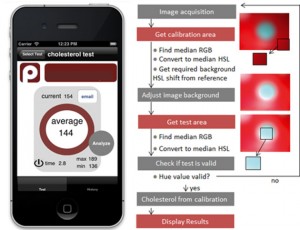A team of scientists from the US have developed a simple system that will allow people to test their blood cholesterol levels at home, using a smartphone.
Cholesterol is an important organic molecule that performs a crucial role in modulating the permeability and fluidity of animal cell membranes, but having too much cholesterol in the blood can be a real problem. In particular, high blood cholesterol levels are known to be a risk factor for coronary heart disease. For many people, blood cholesterol levels can be controlled through diet, by eating less saturated fat. A simple system that enables people to routinely monitor their blood cholesterol levels, using a device that many people already own, would undoubtedly save lives.
David Erickson and co-workers from Cornell University in New York may have developed just that. Their system consists of a small accessory device that attaches onto a smartphone, an app, and dry reagent test strips for measuring blood cholesterol levels that are already commercially available. A drop of blood is placed onto the test strip and an enzymatic, colorimetric reaction occurs. This strip is then placed into the accessory device and an image of the strip is generated using the camera on the phone. The app then quantifies the colour change and converts this into a blood cholesterol concentration using a calibration curve.

A screenshot of the cholesterol monitoring app (left) and the algorithm to process images of the test strips (right)
The achievement of Erickson and his colleagues should not be understated. Although what they have done may sound simple, developing a smartphone-based system that enables precise and reproducible diagnostic measurements to be taken is actually very difficult. The largest challenge comes from having to account for different lighting conditions and reaction times, differences between the cameras and camera settings in different types of phone, and the potential for misalignment of the test strip. The team overcame the lighting problem by using the accessory device to block out external light so that the test strip would be uniformly illuminated by the flash on the camera. Meanwhile, algorithms in the app account for the other potential variables.
‘This work is another excellent demonstration of cellphone-based sensing,’ says Aydogan Ozcan, a point-of-care diagnostics expert at the University of California in Los Angeles, US. Ozcan himself has developed numerous smartphone-based systems and he sees the value in this work: ‘it will provide numerous opportunities, especially for home monitoring and testing of chronic and elderly patients.’
Erickson and co-workers are now working to commercialise their system, so it may be available for the general public to purchase in the near future.
Click here to watch Erickson demonstrate the test in this great video from the Cornell Chronicle.
Or read this news article by Megan Tyler, and many more, on the Chemistry World website.










